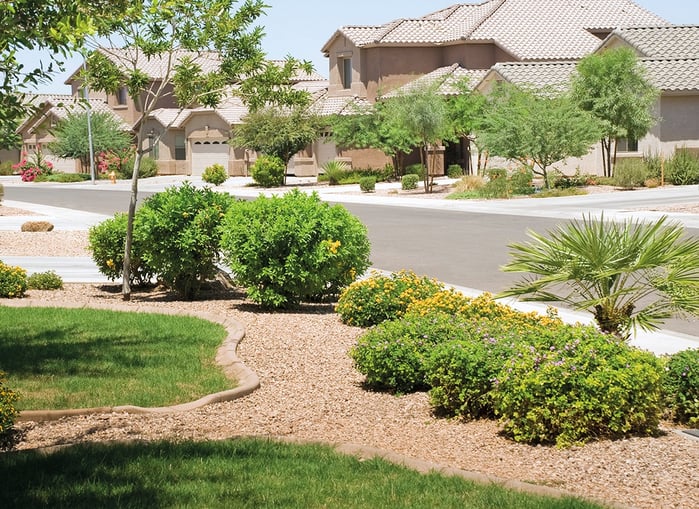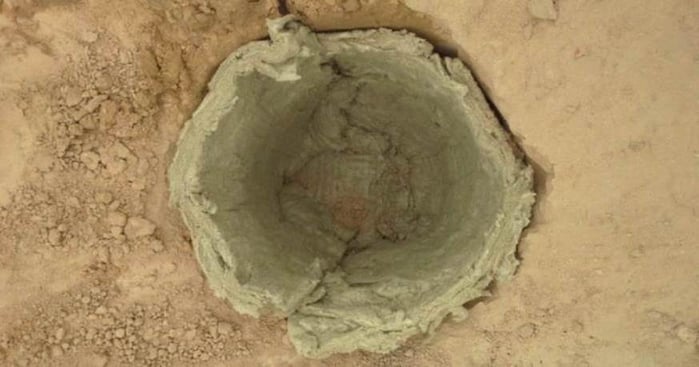In California, the largest part of all urban water usage goes to landscaping.
There, water consumption for outdoor applications can reach as much as 60% of total urban consumption (according to AWWA Research Foundation). Many ongoing initiatives for California's urban landscape management are currently on the table aimed at setting “new norms” for the urban environment. The focus is on creating a self-sustaining environment with self-sufficient vegetation, with the aim of radically reducing water consumption as much as possible.
There are various ways of reducing water consumption, by combining different actions, products and solutions. The Governmental Department of Water Resources is offering rebates for some solutions like the Turf Replacement Rebate Program.
California’s “Turf Replacement Initiative”
The Department of Water Resources (DWR) in California has a rebate program for removing turf and replacing it with landscape schemes that require little water for single-family California residences to support the state's drought response initiative. The $24 million program budget is expected to support the conversion of more than 10 million square feet of turf, or approximately 20 percent of the statewide goal of 50 million square feet of turf. Up to $2 per square foot of removed and replaced turf will be rebated per eligible household. The total rebated amount, including any rebates the homeowner has already applied for from another agency, can't exceed a total of $2 per square foot.
Source: www.water.ca.gov/turf
Urban areas can be managed without spending too much for irrigation by choosing the right products and native plants.
Let’s look at what else can contribute to efficient landscaping management and minimize water consumption.
 Source: iStockphoto
Source: iStockphoto
1. Choosing the right vegetation
One solution is choosing the right vegetation – indigenous plants that don’t need special treatment or watering regimes. While non-native species can affect eco-systems by changing their structure, function and variety of species, choosing native plants to arrange landscapes works toward minimizing habitat destruction. Therefore, using native plant species that are either home grown or nursery propagated is highly recommended.
2. Reduction of turf areas
Reducing turf areas that require large amounts of water can have a significant impact on reducing watering requirements. Instead of laying turf we should choose native plants that are already adapted to the climate and don’t require large amounts of water. The government is offering some rebates for remediation of landscapes to reduce urban water consumption.
3. Rainwater capture and storage
Rainwater capture and storage reduces the strain on existing water supply sources and reduces stormwater runoff, which contributes to reducing stormwater flows that are a leading cause of surface water pollution (rainwater management). Captured water can be employed in a variety of domestic and agricultural uses. And this water can be freely used for watering landscapes when needed.
4. Use of drip irrigation systems
When irrigating our landscapes we should use drip irrigation rather than sprinklers. The fact is that by placing irrigation systems in the actual plant beds there is less possibility of water runoff and evaporation, too.
5. Choosing the right materials for landscaping
Choosing the right materials to build and plant the landscape is the way to protect the environment and save water. In order to reduce irrigation we should first choose some materials that can be incorporated into the ground when initially shaping the landscapes:
By planting shrubs and trees we can use hydro (green) cubes or flocks by placing them in planting pits or planting beds. This will improve soil structure by improving the water-air regime in the ground and reduce water requirements by up to 50%.
By planting turf grass we can save water by putting a hydro (green) blanket in the ground especially designed for such applications; this reduces watering by up to 50%. The main feature of a hydro blanket is that it absorbs large quantities of water that does not escape into the lower layers of the ground. At the same time water is equally distributed horizontally, so it’s highly recommended it be used with a drip irrigation scheme.
 Planting pit with Urbanscape products
Planting pit with Urbanscape products
Materials used depend on the type of soil
Clayish soil is very compact and poorly aerated, and can be improved by adding homemade compost (made of leaves), perlite or hydro (green) flocks made of volcanic rock mineral fibers, which will improve the water-air regime and nutrient storage in the soil.
When dealing with sandy soil, water with nutrients typically seeps into the lower layers of the base ground. By using natural water-retaining materials like volcanic rock mineral hydro (green) cubes or flocks, water can be easily retained and stored in the area where such materials are fixed.
Silty soil is fertile and compact and easily retains moisture. In order to modify and improve it some natural materials should be added to prevent compacting. By adding hydro (green) flocks or cubes made from volcanic mineral rock we can achieve better aeration, and fertile elements or nutrients can be easily absorbed by the plants.
6. Using materials for top cover – mulching
By using some materials for top cover, like mulch, we can prevent plants from drying out and reduce water evaporating from the ground floor. Different natural materials can be used for mulching, such as bark, grass clippings and rock. Bark is recommended when planting non-edible plants, as grass clippings seem to be the most appropriate for edibles. And mulching prevents ground water evaporation and is an excellent way of managing weeds sustainably.
 Source: iStockphoto
Source: iStockphoto
As we see, there are many “natural”, simple and sustainable solutions for reducing water consumption in various landscaping applications. By employing at least some of these ideas and recommendations everyone can make his/her own contribution to protecting the natural environment. And by using native plants and appropriate soil treatments and interventions we can all enjoy a nice looking, environmentally friendly landscape, too.
Interested in Landscaping System and solutions Urbanscape Green Solutions Team can offer? Wondering about Urbanscape Landscaping System benefits? Download our brochure below, read our blog about landscaping in arid areas or check our website for more info.



